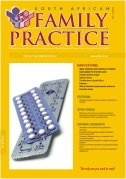Tick Bite Fever in South Africa
Keywords:
tick bite fever, rickettsiae, eschar
Abstract
Tick bite fever has been a constant feature of the South African medical landscape. While it was recognised many years ago that there was a wide spectrum of clinical severity of infection, only recently has it been established that there are two aetiological agents, with different epidemiologies and clinical presentations. Rickettsia conorii infections resemble the classical Mediterranean spotted fever (fièvre boutonneuse), and patients are sometimes at risk of severe or even fatal complications. On the other hand, African tick bite fever is a separate entity caused by Rickettsia africae and tends to be a milder illness, with less prominent rash and little tendency to progress to complicated disease. Irrespective of the agent, the treatment of choice for tick bite fever in South Africa remains doxycycline or tetracycline, and the role of macrolide and quinolone antibiotics is still unclear, or at least restricted.
Published
2008-03-28
Section
CPD
By submitting manuscripts to SAFP, authors of original articles are assigning copyright to the South African Academy of Family Physicians. Copyright of review articles are assigned to the Publisher, Medpharm Publications (Pty) Ltd, unless otherwise specified. Authors may use their own work after publication without written permission, provided they acknowledge the original source. Individuals and academic institutions may freely copy and distribute articles published in SAFP for educational and research purposes without obtaining permission.

